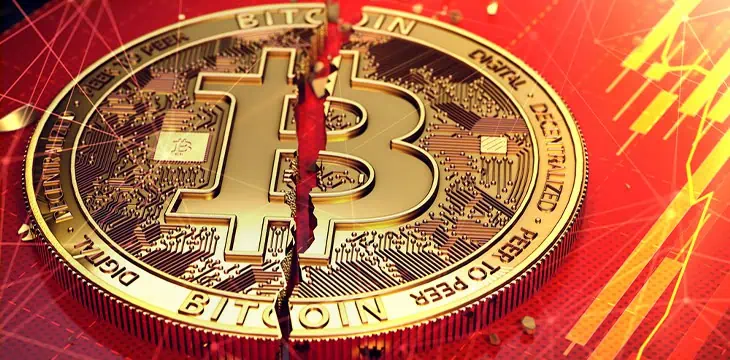|
Getting your Trinity Audio player ready...
|
BTC block reward miners are reeling as the token’s fiat price suffered its biggest drop since the ‘crypto winter’ of 2022, with dire implications for the future security of the blockchain on which the token resides.
‘Crypto’ tokens crashed hard over the weekend and into Monday as a downward trend that prevailed for the past week accelerated sharply. The community identified a number of culprits, including the U.S. market-maker Jump Trading abruptly selling significant token volumes into thin liquidity; Japan’s hiking of interest rates leading to the unwinding of the yen carry trade; fears of a U.S. recession following a disappointing jobs report; and the newly pro-crypto Donald Trump’s path to the White House looking far less certain since incumbent Joe Biden handed his electoral baton to VP Kamala Harris.
Amidst all this carnage, the fact that BTC suffered a far greater price decline than traditional stocks and physical gold could prove the final nail in the coffin for BTC’s ‘digital gold’ mantra. Despite being pitched as a safe haven in times of financial turmoil, BTC’s house of cards has been well and truly exposed as a fraud.
It’s particularly bad timing for U.S. Sen. Cynthia Lummis (R-WY), who just days before the crash, released a draft of her bill to establish a multi-billion dollar strategic reserve of BTC that would “serve as an additional store of value to bolster America’s balance sheet.” Given that BTC’s fiat value fell by more than one-quarter in just the past week, we’re left wondering whether Lummis typed ‘bolster’ when she really meant ‘demolish.’
A week ago, Trump pledged his own form of BTC-based strategic reserve, prompting rapturous cheers from crypto bros, who seemed to forget how they once celebrated the cryptic headline that Satoshi Nakamoto embedded in the Bitcoin genesis block 15 years ago. That headline, about governments bailing out struggling banks, was supposed to indicate the weakness of fiat currency. Now? Bail BTC out, big government… Please?
It’s probably a good thing that Monday’s scheduled virtual meeting of ‘crypto’ execs and White House officials was postponed. The meeting, organized by Rep. Ro Khanna (D-CA), was supposed to focus on nudging the Democratic party away from its perceived anti-crypto stance and encouraging a less restrictive attitude that would see digital assets more firmly integrated with traditional finance. Good luck with that.
Crypto-focused stocks like Michael Saylor’s MicroStrategy (NASDAQ: MSTR) and the Coinbase (NASDAQ: COIN) digital asset exchange tanked in pre-opening trades, with MSTR being down nearly 30% at one point. It probably didn’t help that last week Saylor announced yet another stock dilution plan—this one a $2 billion’ equity offering program’—to buy even more BTC.
Crypto-focused exchange traded funds (ETFs) also took a pounding from the start of Monday’s trading, as investors weren’t able to make any moves on the weekend while the funds’ underlying assets were being set on fire.
The stocks of publicly listed BTC block reward miners like MARA (NASDAQ: MARA) (formerly Marathon Digital), CleanSpark and Riot Platforms (NASDAQ: RIOT) all took double-digit tumbles on Monday morning. While they clawed back some of these losses before the bell rang, none of them finished in the black. So, it’s this aspect of the current debacle that this article will focus upon.
Mining red ink
BTC miners were already struggling due to the recent halving of the block rewards, making a high token price crucial to sustaining miners’ ability to turn a profit. But BTC’s mining difficulty hit a new all-time high last week, meaning it now costs even more to compete for the right to mine a new block.
Miners relying on aging hardware are at a particular disadvantage in this fight, as their rigs continue to devour expensive electricity without a decent shot at the reward that comes from mining a new block. This struggle was on full display in the Q2 reports of publicly traded mining groups, including two of the trio mentioned above.
CleanSpark won’t report its latest quarterly results until later in the week, but Riot Platforms said it generated revenue of $70 million in the three months ending June 30, while booking a net loss of $84.4 million. That loss would have been worse were it not for the nearly $14 million in ‘power credits’ it received from public utilities in the states in which it operates.
MARA didn’t perform any better, reporting revenue of $145 million and a net loss of just under $200 million, much of that via the ‘fair value’ decline of the more than 20,000 BTC tokens it holds. Despite this impairment, MARA recently announced that it had made “a shift in our treasury policy and adopted a full HODL approach to retain all BTC going forward, reflecting our confidence in the long-term value of BTC.” Coming as it did just as BTC’s value peaked and plummeted, this confidence looks a little misplaced.
Unplugged
Both Riot and MARA justifiably cited April’s halving event as a negative drag on revenue. Expect some of the more disadvantaged mining firms to either sell their underperforming operations—Riot just paid $93 million to acquire Kentucky-based rival Block Mining—or switch their focus to serving as artificial intelligence (AI) data centers.
That is, assuming the authorities don’t pull the plug first. As BTC mining and AI data centers hoover up every available watt of electricity, more and more state legislators—many of them Republicans, just to remove any suggestion that this is more ‘Dems hate crypto’ talk—are wondering where the hell this ends.
This has miners looking further afield for cheap electricity to exploit. MARA recently signed a deal with Kenya’s government with the stated purpose of “developing underutilized energy assets.” If by ‘developing’ they mean devouring, okay, but we suspect the Kenyans don’t know what’s about to hit them.
On a lighter note, some small-scale crypto miners are taking alternative routes, including renting out Airbnb homes, installing mining rigs and running up massive electricity bills that the hosts only find out about after the fact. No doubt some ‘crypto’ entrepreneur is already launching ‘AirBTC’ to direct minnow miners to unsuspecting hosts with lots of electrical outlets.
Entering endgame
BTC’s transaction consensus mechanism was already showing worrying signs of concentration, as just two mining pools currently account for over half of all BTC hash rate. Throw in these groups’ proxies and the dominance is even more stark.
The unforgiving economics of mining will only hasten this concentration, and make a mockery of the BTC camp’s previous veneration of the concept of decentralization. What was once unthinkable is no longer theoretical: the BTC blockchain’s security is headed for a fall.
BTC’s seeds of self-destruction were sown seven years ago, when the BTC Core developers diverged from Satoshi’s original plan by capping the network’s block-size at 4Mb. Stripped of all utility, BTC had no purpose left beyond a speculative asset.
Publicly, this step was pitched as ensuring that all users could continue to run a ‘full node’ (that didn’t actually produce any blocks of its own). But the main goal was to shunt transactions off the main network onto proprietary layer-two ‘solutions’ like the Lightning Network, in which many of the same BTC Core developers had an economic stake.
Satoshi always viewed the block subsidy as a temporary incentive, much as Bitcoin’s original 1Mb block-size was intended as a temporary measure to protect the fledgling network from being spammed into submission.
The block-size was always intended to grow, and with it the number of transactions you could fit into a single block. The fees from these transactions would eventually supplant the subsidy—which is why the subsidy was designed to steadily reduce over time—and ensure the network could grow to meet the needs of its users.
But BTC decided the artificial scarcity of ‘digital gold’ was the way to go, and its acolytes worked overtime to convince the world to buy into this fallacy. But nobody can ever tell you precisely why BTC’s ‘number go up,’ while there are a million excuses for why it sinks like a stone, and none of them are ever BTC’s fault.
There is an alternative to this madness. The BSV Blockchain never broke faith with Satoshi’s vision, maintaining an unbroken link to the Genesis block. BSV imposes no block-size cap, allowing it to handle exponentially more transactions than BTC—at the same energy cost per block—while keeping transaction fees to a tiny fraction of BTC’s.
You know, it’s almost as if the utility-focused BSV was more deserving of the term ‘bitcoin’ than BTC… and has more of a future.
Watch: Teranode & the Web3 world with edge-to-edge electronic value system

 07-02-2025
07-02-2025 





